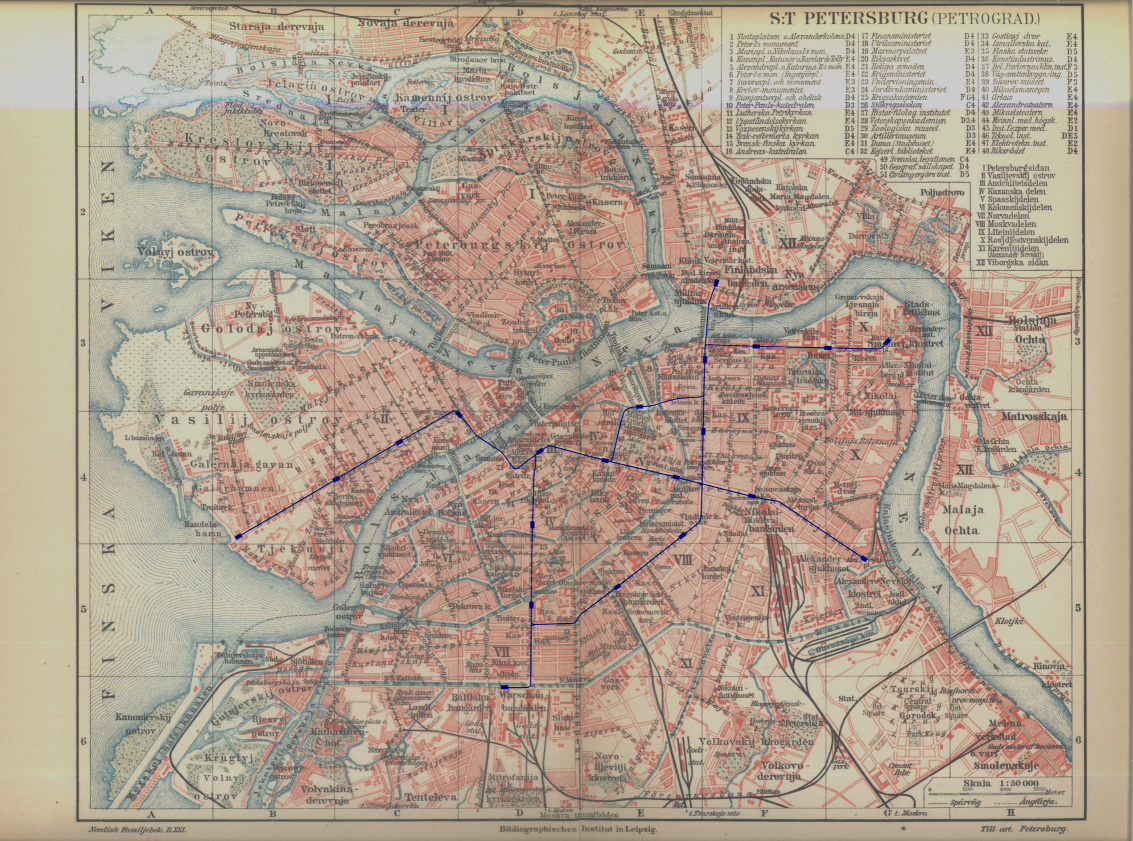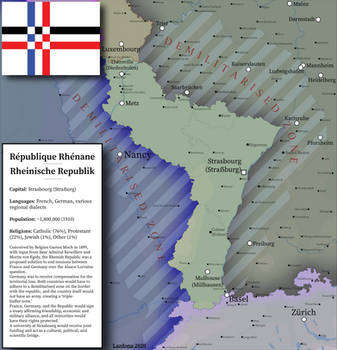ShopDreamUp AI ArtDreamUp
Deviation Actions
Description
What do you get when you mix insomnia, Russophilia, rail enthusiasm, and alternate history? Why, the Saint Petersburg Elevated, of course!
***
From "A History of Saint Petersburg" by A.V. Kosygin
Saint Petersburg State University, 1954
By the turn of the 20th century, Saint Petersburg faced a population explosion, growing from 954,000 inhabitants in 1890 to 1,782,000 at the outbreak of the Second European War. While it is true that these numbers can be explained in part by several large annexations made in that period, the fact still remains that it was a rapidly growing city, and the tramways were hard-pressed to cope with the masses of people moving about the city. A particular problem lay with the railroads, each of which had been built with a separate terminal in the city to avoid the demolition of large swathes of the historic city centre that a central station would mean. Eventually there were five different stations in the city [1], and the streams of people moving between these were growing beyond tramway capacity.
Theoretical solutions to these problems were legion, and had in fact been proposed for several decades; as early as the 1810s, a city resident named Torgovanov presented Alexander I with plans and a cost assessment for the construction of a road tunnel linking the admiralty building and Vasilevsky Island; this was immediately rejected by the emperor, who made Torgovanov sign a pledge "not to engage in such hare-brained schemes in the future, but to exercise (his) efforts in matters appropriate to (his) station". Several other plans met with the approval of the press and the people, but were all either rejected by the emperor as too expensive or made impossible to realise by the lack of engineering skill in the city [2]. However, in 1898 a German engineer by the name of Eugen Langen [3] offered his services in designing an urban rail system, winning the approval of the City Duma and the national one, and immediately set to work on what would become the first leg of the Saint Petersburg Elevated Railway.
Before Langen's proposal was accepted, there had been several proposals for an underground railway, similar to the London one. This was deemed infeasible, however, given the softness of the soil under the city [4], and the system Langen proposed would be entirely elevated. It was less ambitious than some other proposals, but still included some twenty kilometres of rail, linked all five railway terminals, and provided easy access to large parts of the city. The system was based around a ring line, running from a central station by the admiralty building, down Nevsky Prospekt, Vladimirsky Prospekt, Zagorodny Prospekt, and Voznesensky Prospekt, from where it crosses Saint Isaac's Square and returns to the station. To this were added branches running to the Warsaw, Moscow and Finland stations, as well as Vasilevsky Island and Taurida Palace.
By the time the line opened in 1904, however, it only included the ring, and when the Second European War broke out only the branches to Moscow and Warsaw Stations had been completed. At this point construction ground to a halt, as what few industrial resources Russia had at the time were geared entirely toward war production. When the war ended, there was very little money left in the treasury, but the Argunov ministry prioritised transit construction, and after a short period of construction, the branches to Finland Station and Taurida Palace finally opened on July 21, 1926, followed by the Vasilevsky Island branch three months later.
The lines were organised into four fixed services as follows:
- Ring line
- Warsaw Station-Admiralty-Moscow Station-Alexander Nevsky Monastery
- Vasilevsky Island-Admiralty-Summer Palace-Taurida Palace-Smolny Monastery
- Warsaw Station-Tsarskoye Selo Station-Finland Station
***
[1] Going from the north and clockwise, these are: the Finland Station (Финляндский вокзал), the Moscow Station (Московский вокзал), the Tsarskoye Selo Station (Царскосельский вокзал; today this station is called the Vitebsk Station), the Warsaw Station (Варшавский вокзал; was closed in 2001 and now serves as a museum) and the Baltic Station (Балтийский вокзал).
[2] All of this is OTL.
[3] Langen is an OTL figure, and famously designed the Schwebebahn (suspension railway) in the German city of Wuppertal, as the proof of concept for a design he hoped to sell to Berlin. ITTL he never gets the chance to try the system out, and so it remains a hare-brained idea to much of the world.
[4] This is obviously a problem IOTL as well, and so, when the Saint Petersburg Metro was finally built, it was built deep, in order to utilise the bedrock. In fact, it's the deepest system in the world measured by average station depth, and its very deepest station (Admiralteyskaya, under the Admiralty Building) is the second deepest underground station in the world, with a mean depth of 86 metres (282 feet).
***
From "A History of Saint Petersburg" by A.V. Kosygin
Saint Petersburg State University, 1954
By the turn of the 20th century, Saint Petersburg faced a population explosion, growing from 954,000 inhabitants in 1890 to 1,782,000 at the outbreak of the Second European War. While it is true that these numbers can be explained in part by several large annexations made in that period, the fact still remains that it was a rapidly growing city, and the tramways were hard-pressed to cope with the masses of people moving about the city. A particular problem lay with the railroads, each of which had been built with a separate terminal in the city to avoid the demolition of large swathes of the historic city centre that a central station would mean. Eventually there were five different stations in the city [1], and the streams of people moving between these were growing beyond tramway capacity.
Theoretical solutions to these problems were legion, and had in fact been proposed for several decades; as early as the 1810s, a city resident named Torgovanov presented Alexander I with plans and a cost assessment for the construction of a road tunnel linking the admiralty building and Vasilevsky Island; this was immediately rejected by the emperor, who made Torgovanov sign a pledge "not to engage in such hare-brained schemes in the future, but to exercise (his) efforts in matters appropriate to (his) station". Several other plans met with the approval of the press and the people, but were all either rejected by the emperor as too expensive or made impossible to realise by the lack of engineering skill in the city [2]. However, in 1898 a German engineer by the name of Eugen Langen [3] offered his services in designing an urban rail system, winning the approval of the City Duma and the national one, and immediately set to work on what would become the first leg of the Saint Petersburg Elevated Railway.
Before Langen's proposal was accepted, there had been several proposals for an underground railway, similar to the London one. This was deemed infeasible, however, given the softness of the soil under the city [4], and the system Langen proposed would be entirely elevated. It was less ambitious than some other proposals, but still included some twenty kilometres of rail, linked all five railway terminals, and provided easy access to large parts of the city. The system was based around a ring line, running from a central station by the admiralty building, down Nevsky Prospekt, Vladimirsky Prospekt, Zagorodny Prospekt, and Voznesensky Prospekt, from where it crosses Saint Isaac's Square and returns to the station. To this were added branches running to the Warsaw, Moscow and Finland stations, as well as Vasilevsky Island and Taurida Palace.
By the time the line opened in 1904, however, it only included the ring, and when the Second European War broke out only the branches to Moscow and Warsaw Stations had been completed. At this point construction ground to a halt, as what few industrial resources Russia had at the time were geared entirely toward war production. When the war ended, there was very little money left in the treasury, but the Argunov ministry prioritised transit construction, and after a short period of construction, the branches to Finland Station and Taurida Palace finally opened on July 21, 1926, followed by the Vasilevsky Island branch three months later.
The lines were organised into four fixed services as follows:
- Ring line
- Warsaw Station-Admiralty-Moscow Station-Alexander Nevsky Monastery
- Vasilevsky Island-Admiralty-Summer Palace-Taurida Palace-Smolny Monastery
- Warsaw Station-Tsarskoye Selo Station-Finland Station
***
[1] Going from the north and clockwise, these are: the Finland Station (Финляндский вокзал), the Moscow Station (Московский вокзал), the Tsarskoye Selo Station (Царскосельский вокзал; today this station is called the Vitebsk Station), the Warsaw Station (Варшавский вокзал; was closed in 2001 and now serves as a museum) and the Baltic Station (Балтийский вокзал).
[2] All of this is OTL.
[3] Langen is an OTL figure, and famously designed the Schwebebahn (suspension railway) in the German city of Wuppertal, as the proof of concept for a design he hoped to sell to Berlin. ITTL he never gets the chance to try the system out, and so it remains a hare-brained idea to much of the world.
[4] This is obviously a problem IOTL as well, and so, when the Saint Petersburg Metro was finally built, it was built deep, in order to utilise the bedrock. In fact, it's the deepest system in the world measured by average station depth, and its very deepest station (Admiralteyskaya, under the Admiralty Building) is the second deepest underground station in the world, with a mean depth of 86 metres (282 feet).
Image size
1133x841px 2.1 MB
Comments7
Join the community to add your comment. Already a deviant? Log In
So the empire survived WWI in this timeline?














![[RTL] The Tussenland Railroad (English/Amerikaans)](https://images-wixmp-ed30a86b8c4ca887773594c2.wixmp.com/f/32947cf7-5973-49ed-a695-42c68ee0327a/delslvw-db1d55d9-a3ab-45e1-87f4-348205ac3c14.jpg/v1/crop/w_184)
![[RTL] The Dutch Mexican-War (1901-1903)](https://images-wixmp-ed30a86b8c4ca887773594c2.wixmp.com/f/32947cf7-5973-49ed-a695-42c68ee0327a/dep19do-07565568-f148-48f2-a977-35ce131fd3e8.jpg/v1/crop/w_184)
![[RTL] - Europe A.D. 1757](https://images-wixmp-ed30a86b8c4ca887773594c2.wixmp.com/f/32947cf7-5973-49ed-a695-42c68ee0327a/de3z9uf-f3b192db-06ba-4be8-ae3c-3c915eec3232.jpg/v1/crop/w_184)


![Spartacist Uprising of 1919 [Commission]](https://images-wixmp-ed30a86b8c4ca887773594c2.wixmp.com/f/b6a1725d-a8a9-4914-9b52-42f891a308a8/dczsjpl-8fbbc758-a846-4051-9cf7-d03c8a136cf4.png/v1/crop/w_184)




![Kaiserreich [COMMISSION]](https://images-wixmp-ed30a86b8c4ca887773594c2.wixmp.com/f/117e419e-1894-40ba-81b8-ca932221601e/db4r8ks-34477c01-14e4-43ab-b392-b029acd37b59.png/v1/crop/w_184)








